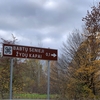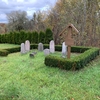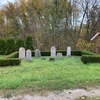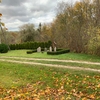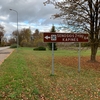EN:
The Jewish community in Babtai was established relatively early, with one Jewish family already living in the town by 1738. By 1765, there were 32 Jews residing in the town, occupying eight houses. Until the middle of the 19th century, the Jews of Babtai belonged to the Jewish community of Vandžiogala. In the mid-19th century, Jews constituted the majority of the population, engaged in crafts and trade, and maintained a synagogue, a ritual bath, a slaughterhouse, and a school.
The candle tax list of 1858 provides insight into the trades and wealth of the town’s Jews: there were five tailors, three bakers, two fabric dyers, two shoemakers, one carpenter, one tinsmith, and one coachman. Seven persons were named as property owners. In the 19th century, Babtai had a synagogue, a cemetery, a bathhouse, a ritual slaughterhouse, and a religious primary school. According to the 1912 list, 38 families belonged to the Babtai Jewish community, so it is estimated that no more than 200 Jews lived in the town at that time.
During the First World War, the Jews were expelled to the interior of Russia. After the restoration of Lithuanian independence, 153 Jews lived in Babtai in 1923, but their number declined due to emigration. Until the Second World War, Babtai was still home to about 40 Jewish families. The Jews of Babtai operated teahouses and shops, and were active in livestock and fruit trade, blacksmithing, shoemaking, hairdressing, tailoring, and photography. Rabbi Moshe Eliyahu Burstein, son of Yaakov, served the community from 1878 until he died in 1924. For some time, the Jewish community of Babtai relied on the services of the rabbi in Kėdainiai, until they appointed Rabbi Shlomo Pudliash in the late 1930s.
In the summer of 1941, during the German occupation, local nationalists murdered 89 of the town’s Jews — men, women, and children — in the forest by the Nevėžis River, and buried their remains in pre-dug pits. Today, a monument stands at the site, testifying to the tragic fate of the community.
The Babtai Jewish cemetery was established on the left bank of the Teškupis stream, away from the town’s main street. The terrain here is distinctive — a hill with a steep slope on the western side, overgrown with fruit trees and bushes. Unfortunately, in 1991, during the construction of the town’s water supply and sewerage system, approximately two metres of the cemetery’s surface were removed, effectively destroying it. Only a few granite headstones with Hebrew inscriptions survived. These were gathered and placed in a memorial area in the northern part of the former cemetery in 1998.
General view by M. Jakulytė, 2022
The cemetery documented in 2024. Photographer Sergey Kanovich, translation by Joel Suldan in 2024.
LT:
Babtuose žydų bendruomenė įsikūrė palyginti anksti – jau 1738 m. miestelyje gyveno viena žydų šeima, o 1765 m. – jau 32 žydai, turėję aštuonis namus. Iki XIX a. vidurio Babtų žydai priklausė Vandžiogalos žydų bendruomenei. XIX a. viduryje žydai sudarė gyventojų daugumą, užsiėmė amatais, prekyba, turėjo sinagogą, ritualinę pirtį, skerdyklą, mokyklą. 1858 m. žvakių mokesčio sąrašas leido susidaryti vaizdą apie miestelio žydų amatus, turtą: miestelyje buvo 5 siuvėjai, 3 kepėjai, 2 audinių dažytojai, 2 batsiuviai, po vieną dailidę, skardininką ir vežiką. Septyni asmenys įvardinti savininkais. Babtuose XIX a. buvo sinagoga, kapinės, pirtis, ritualinė skerdykla, religinė pradžios mokykla. 1912 m. sąrašo duomenimis Babtų žydų maldos namų bendruomenei priklausė 38 šeimos, tad spėjama, jog miestelyje gyveno ne daugiau kaip 200 žydų. Pirmojo pasaulinio karo metu žydai buvo išvaryti į Rusijos gilumą. Atgavus nepriklausomybę, 1923 m. Babtuose gyveno 153 žydai, tačiau jų skaičius mažėjo dėl emigracijos, tačiau iki pat Antrojo pasaulinio karo Babtuose vis dar gyveno apie 40 žydų šeimų. Babtų žydai turėjo arbatinių, parduotuvių, užsiėmė prekyba gyvuliais, vaisiais, kalvyste, batsiuvyste, kirpimu, siuvimu, fotografija. Rabinas Moše Elijahu, Jakovo, Buršteinas tarnavo miesto bendruomenei nuo 1878 iki savo mirties 1924 metais. Kurį laiką Babtų žydų bendruomenė naudojosi Kėdainių rabino paslaugomis, kol XX a. 4 dešimtetyje pasamdė rabiną Šlomo Pudliaš.
1941 m. vasarą vokiečių okupacijos metu vietiniai nacionalistai nužudė 89 miestelio žydus – vyrus, moteris ir vaikus – jie buvo sušaudyti miškelyje prie Nevėžio, o palaikai užkasti iš anksto iškastose duobėse. Šiandien toje vietoje stovi paminklas, liudijantis tragišką bendruomenės likimą.
Babtų žydų kapinės buvo įkurtos kairiajame Teškupio upelio krante, atokiau nuo pagrindinės miestelio gatvės. Reljefas čia išraiškingas – kalvelė su stačiu šlaitu vakaruose, apaugusi vaismedžiais ir krūmais. Deja, 1991 m. tiesiant vandentiekį ir kanalizaciją, kapinių paviršius buvo nubrauktas apie 2 metrus – jos buvo faktiškai sunaikintos. Išliko tik keli tašyto granito paminklai su hebrajiškais įrašais, jie 1998 metais buvo sudėti į memorialą šiaurinėje buvusių kapinių dalyje.
Bendro vaizdo nuotraukos M. Jakulytės, 2022 m.
Kapinės dokumentuotos 2024 m. Fotografas Sergejus Kanovičius, vertėjas Joel Suldan.
